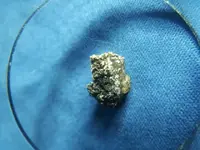Hi BiggusDiggus… a silver sample’s benchtest target ID results from its physical / chemical make-up. Silver purity, types of mineral inclusions, structure, size, and shape are the primary factors that impact target ID. Generally naturally occurring gold and silver pretty much share the same target ID range.
Even very minor inclusions of other minerals will degrade silver’s electrical conductivity to a far greater degree than their compositional percentage would seem to indicate. The bulk of silver ores found by hobbyists are low conductives that target ID from low foil to mid-pulltab range. Nearly all natural silver in this area does not exceed the silver dime range, exceptions are extremely rare. So one can see that target ID readouts have little or no value when attempting to distinguish natural silver from other similarly conductive metals.
Your sample does look like naturally occurring tarnished silver, but that doesn't mean it is. Do a quick streak test on the specimen by running it across a piece of unglazed porcelain. Unfinished bottoms of coffee mugs will work fine for this test. Silver produces a silver-white metallic streak, whereas other silvery / white sulfides will not give a similar streak… normally these are dark brown to black… but not silvery / white.
Next check the malleability by seeing if the metal can be indented with a sharp instrument such as a butterknife. You’ve noted above that this is the case. Similar appearance sulfides will crumble with enough pressure, but in any case they will not be malleable.
Silver hardness = 2 to 2½ generally. Platinum for example, is harder at 4 to 4½, much heavier, and insoluble in nitric acid. Native silver will dissolve in nitric acid, producing an insoluble, curdled silver chloride precipitate with HCl addition. No other white malleable metal that is soluble in nitric acid is ever likely to be encountered in a prospecting context.
Finally, check the hardness of the light-hued host rock to determine if a calcite or carbonate composition is suggested, the hardness should reside right around 3ish. Silver up here is nearly always associated to some extent with these minerals.
Of course it would also be useful to know if this specimen was detected in a known silver-producing area. Hope these suggestions are helpful.
Jim.





